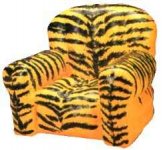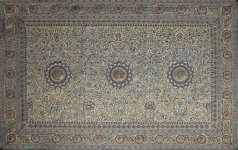Awaiting evidence...
None of the story put up with the auction points to this 'carpet' being part of a group... the use seems to point to the contrary, and the tension around its making (sounds like the clan was uneasy enough about having just this one made)... previous exhibits.
The design does remind of carpets meant for assembly, but I doubt this is very relevant. Here's the reasoning:
I have ZERO experience with fine oriental carpets. And perhaps that's one big reason why I am seeing this thing as a religious object - not necesarily a 'carpet'. After all, nothing in its making relates to carpets at all - perhaps embroidery, the jewelry trade... Also, tomb covers are a very broad, eclectic category: among historic bequests in kind, the ones using typical carpet-making techniques are anything but the rule.
It sounds to me that the auctioneer wanted to avoid calling this object a 'tomb cover' (perhaps in line with the commissioner's unease with that intended use of the object... perhaps with the sensibilities of a more eclectic marketing mind.
Wonder what this will be bought for? It would be quite a feat if it ended up in Medina after all. Now that for headlines! ]
I am as curious as any about whether other similar things (by any interesting definition) exist. After all, not much really is 'one of a kind'.
Speaking of tomb covers...
It must by quite extravagant on the hypothetical 'scale' of tomb covers. However, lavish 'textiles' meant for this function add up to a large and diverse class of objects. And the type of object was / is a typical form of religious bequest - some of historical significance (
what better advertising board then a popular shrine.)
Now, there is a reason why I do no 'see' the sort as a type of 'carpet'... The examples I have seen (Christian, in the Byzantine fashion: of Romanian, Russian, Greek, Hungarian, Austrian and German origin / dated between 1400 and 1800, I think - no special quest, just visiting church museums all over the place. It's a kind of sport...) could be defined as a class of 'extravagant, singular covers some donor could come up with, in line to whatever skills the respective community and time in history allowed'. The results are one of a kind flights of personal fancy that combine crafts and materials in unique ways - not unlike the beaded pearl throw at auction ('carpet' sounds that much better then 'tomb throw', doesn't it). One fellow that used to rule north of here around 1500 recounted military exploits in gold embroidery and seed pearls on such 'manifesto' tomb covers... a dozen coming with a matching church

Other examples from more stable, more affluent places and times are easily examples of jewelry - much like the pearl carpet that started the story.
Clearly, India is better place then most to look for the intersection between embroidery and jewelry - precious threads, jewelry meant for application on clothing: ideas rather alien to European jewelry (well, almost). That pearl thing brings together the crafts and tastes of that place. Its pattern is one super popular representation of heaven in a tradition with strict rules on graphic representation. The inlaid marble of Taj Mahal that is mentioned in the auction intro references the same concept. Carpets and a myriad of finer things did / do the same.
Frankly,
I do not know whether the history of tomb covers is written anywhere in one place - I'd bet it is. An enormous class of 'monumental textiles' - if anything deserves the description. Someone ought to have written of them! I'd rather look this sort of reference up rather then carpets in general...
I'll wait for Google Books to kick in for this one though, LOL! - rather
exotic subject...
Sure enough, I know nothing of the really useful, close references. Just trying to make sense of an 'alien' thing against the closest genre I can think of, if you wish. The practice got me in trouble more then once!
 PS.
PS.
Ever doubted there is a
modern take on sale? LOL!
(Google, the bastards!

)
PPS.
Don't have any good excuse for the self-indulging rant! Only that everyone else is free to do the same. Promise' to read.





